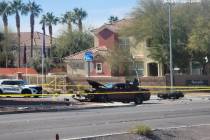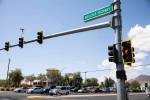Here’s one way to keep trash moving along the road
The recent submission about the "unthinking lout" who threw three bags of trash out of his SUV window while driving on the south Las Vegas Beltway spurred some interesting feedback, including this entertaining remembrance by reader Frank:
"Several years ago, my friend Dan and I were on westbound Sahara Avenue, waiting to make the left-hand turn onto Interstate 15 south, when we see the driver of the car in front of us open his door and set a six-pack of empties next to the curb.
"Dan shifts his car into park, gets out and walks briskly over to the abandoned six-pack, picks it up, looks the driver in the eye, opens the rear door of his sedan and throws the empties in the back. Then Dan looks the driver in the eye and says, 'If you want to do anything but talk about this, get outta the car.'
"About that time, the signal changes and the 'lout' hastens on his way. Dan, meanwhile, walks back to his car to a large round of applause from the drivers waiting behind him. We all made it through the traffic signal before it turned amber."
While the Road Warrior never, ever, ever would recommend such a course of action - or reaction - he can't help but smile.
Now on to some readers' questions.
Edward of Henderson wonders what's the deal with so many Hawaii license plates in Southern Nevada. He points to a residence in his neighborhood where four vehicles - two cars and two trucks - all have Hawaii plates: "They have been here for over six months. How can they get away with this? I thought you had to get Nevada plates within 30 days of moving here."
First, let the Road Warrior say mahalo for your question.
Second, remember Las Vegas (we'll let that include Henderson, for this point) is affectionately considered by Hawaiians to be the "ninth island."
Third and most important, you are correct, as Kevin Malone, public information officer for the Nevada Department of Motor Vehicles, explains: "Nevada law requires new residents to register within 30 days. There is no special exception for Hawaii plates. New residents from any state believed to be violating the registration law can be reported to the constable's office at 455-FAIR."
So, Edward, it's up to you whether to let the matter slide or to turn them in with an anonymous "Book 'em, Danno."
Douglas' parents will be flying in for a three-month stay around Christmas. Because his father suffers from emphysema and requires a wheelchair to get around, Douglas asks, "Can my father's out-of-state handicap placard be used with my vehicle, and is any special authorization letter required?"
The Road Warrior again turns to the DMV's Malone, who clears up Douglas' confusion - and probably answers a question a lot of Southern Nevada residents have regarding transporting disabled family members and friends who visit from out of state: "Nevada accepts other states' placards. The placard holder does not have to possess an authorization letter."
Matt loves the freeway beautification work that's being done around the valley, but he has a big concern: boulders. As in decorative rocks found at some offramps. He wonders whether they pose a safety hazard, specifically the one on the Lake Mead Boulevard exit of U.S. Highway 95 north: "If a car were to lose control on that curve, good luck. ... Hitting one at 65 mph would surely result in a fatality."
Well, blood stains would defeat the "beautification" effect, now wouldn't it?
Not to fear, explains Damon Hodge, public information officer for the Nevada Department of Transportation, which is responsible for the artwork:
"As it relates to landscape, architecture and aesthetics, we carefully check our plans to ensure that all items, including elements over 4 inches in diameter, are out of the clear zone" - defined as the unobstructed flat area provided beyond the edge of the traveled roadway for the recovery of errant vehicles - "per guidelines established by the American Association of State Highway and Transportation Officials. During construction, we reconfirm that those objects are out of the clear zone. The clear zones are based on slope, speed and distance.
"Roadway design is based on a clear zone of 30 feet from the traveled roadway. Objects either have to be removed from the clear zone, or if they are appurtenances such as signs, poles, etc., then they have to be breakaway.
"The area the reader is referring to was double-checked during construction. It's technically outside the clear zone, but is an attention-getter because of the curve of the road."
Lorraine is frustrated with the daily headache that is the backup to get on Interstate 15 northbound at Silverado Ranch Boulevard. She says the much-needed aspirin is the onramp planned as part of the Cactus Avenue interchange. She asks, "Any update on when that might happen?"
Hodge of NDOT feels your pain. He says construction is targeted to start in the spring.
In the meantime, Lorraine, the Road Warrior recommends traditional, over-the-counter painkillers.
If you have traffic questions or gripes, email them to roadwarrior@reviewjournal.com. Please be specific, and include your phone number. Not all questions can be answered in print. Follow the Road Warrior on Twitter: @RJroadwarrior.
• Northbound Interstate 15 offramp to westbound Charleston Boulevard closed daily from 9 p.m. to 5 a.m. Friday for bridge repairs.
• Lane closure on westbound Tropicana Avenue, between Paradise Road and Koval Lane, from 9 p.m. to 5 a.m. daily through Oct. 22 for drainage structure repairs.
• Lane closures at the intersection of Las Vegas Boulevard South and Flamingo Road from 2 to 10 a.m. today and Thursday for manhole rehabilitation.
• Lane closure on Eastern Avenue at Warm Springs Road today and Thursday for Water Reclamation District survey.
• Lane closure on Windmill Lane, from Paradise Road to Maryland Parkway, today and Thursday for Water Reclamation District survey.
• Disruptions on Buffalo Drive, between Lake Mead and Charleston boulevards, through late October for road improvements.
• Lane closure on Shadow Lane, between Alta Drive and Charleston Boulevard, through Oct. 31 for utility work.
• Lane closure on Lamb Boulevard, from Oquendo Road to Hacienda Avenue, through Nov. 2 for Water Reclamation District survey.
• Lane closure on Nellis Boulevard, from Hacienda Avenue to Flamingo Road, through Nov. 2 for Water Reclamation District survey.
• Lane closure on Hacienda Avenue, from Lamb Boulevard to Grapevine Springs Park, through Nov. 2 for Water Reclamation District survey.
• Night lane closure on Sunset Road, from Eastern Avenue to McLeod Drive, through Nov. 2 for Water Reclamation District survey.
• Night lane closure on Warm Springs Road, between Tamarus Street and Eastern Avenue, through Nov. 2 for Water Reclamation District survey.
• Night lane closure on Spencer Street, from Warm Springs Road to Eldorado Lane, through Nov. 2 for Water Reclamation District survey.
• Lane restrictions on both directions of Decatur Boulevard, between Lake Mead Boulevard and Rancho Drive, for five weeks for paving and median island improvements.
• Intersection of Lake Mead Boulevard and Pecos Road closed for Las Vegas Valley Wash box culvert upgrade.
• Delays on Jones Boulevard from U.S. Highway 95 to Sahara Avenue for widening.
GASOLINE PRICES
The average price of gasoline Tuesday in the Las Vegas Valley was $3.77 per gallon; the state average was $3.91; the national average was $3.80.
LAS VEGAS REVIEW-JOURNAL























